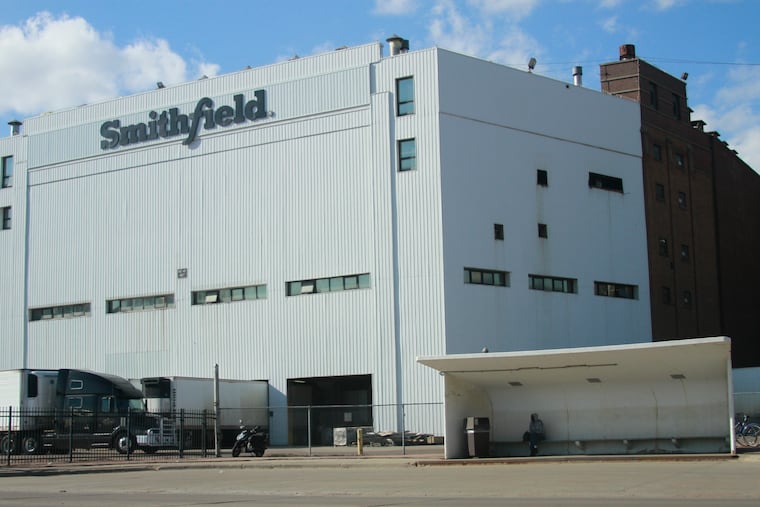Slaughterhouses that supply America’s meat are starting to close because of coronavirus
Sunday, one of America's largest pork slaughterhouses shut down after more than 200 workers tested positive for the virus. A day later, a massive beef-processing plant in Colorado announced it's winding down operations.

On Sunday, one of America's largest pork slaughterhouses shut down after more than 200 workers tested positive for the coronavirus. A day later, a massive beef-processing plant in Colorado announced it's winding down operations.
In Canada at least five meat plants have halted operations since the end of March. And most companies haven't said exactly when they'll reopen.
To be clear: Nobody is saying North America is running out of meat yet. In fact, refrigerated inventories remain robust across the U.S. and most plants remain open. But the virus, which has now infected hundreds of meat-plant workers in the region, is spreading — and the prospect of prolonged shutdowns has the boss of Smithfield, the world's top pork producer, warning America is "perilously close" to a shortfall.
What makes meat supplies especially vulnerable is the fact that they need to be refrigerated. And there's only so much fridge space, said Krista Foster, who teaches Supply Chain Management at the University of Notre Dame's Mendoza College of Business. "Once the existing inventory is used up, consumers can expect to see smaller quantities of pork products in stores due to processing plant closures."
The shutdowns are creating such a backup in livestock that some farmers are already euthanizing their animals — it’s a last-resort practice only employed when their pigs and cows have absolutely nowhere else to go. And if more plants shut down and wholesale prices fall further, it’ll only become more widespread, said David Herring, a hog farmer and board member for the National Pork Producers Council.
Plant slowdowns will "cause a serious backlog in animals," said Dennis Smith, senior account executive at Archer Financial Services Inc. "The worst fears in the industry are now becoming reality."
The problem for farmers is they have nowhere to keep surplus hogs that don't make it to slaughter, said Dermot Hayes, an Iowa State University economics professor who likened the plant closures to "putting a barrier on the exit of an elevator that is full of people."
U.S. pork output was already falling last week and so was beef production. In the case of pork, 8% of capacity may now be down because of the pandemic, according to Kerns and Associates.
While frozen stockpiles are high, the slaughterhouse interruptions come at a time of unprecedented disruptions along the supply chain as companies try to shift their production lines to supply supermarkets instead of restaurants. If more plants shut, fresh-meat shortages may start to appear as stocks run down.
Shortages are possible down the line but unlikely now, said Joshua Specht, a visiting assistant professor at the University of Notre Dame. "As far as an absolute shortage, the pandemic would have to shift into some of the more grim forecasts, which is certainly possible, but at this point it's hard to say."
If the trend of extended shutdowns continues, retailers domestically and abroad may be forced to buy from somewhere else. The U.S. typically exports about a quarter of its pork and about 14% of its beef, according to the U.S. Meat Export Federation.
China, the top global pork consumer, has been slowly emerging from coronavirus. Shipments of U.S. pork to China have picked up, and the slaughter halts could disrupt that even as importers in Asia could be taking advantage of low pork prices now. While operations in another meat-exporting heavyweight, Brazil, have so far been largely unaffected by the virus, its spread is some weeks behind the U.S. curve.
Abundant supplies of both hogs and pork should help buffer some of the disruptions. The U.S. hog herd is the largest ever for March, at 77 million, U.S. Department of Agriculture data shows. Pork supplies in U.S. cold storage in February of 662 million pounds were up 7.5% from the same month a year ago.
Still, Smithfield, which is closing the Sioux Falls facility until authorities clear it to reopen, said it would be impossible to keep stores stocked if plants aren't running. Hog futures fell by their daily limit on the news to the lowest since October 2016. U.S. cattle futures also slumped Monday.
Julie Anna Potts, CEO of the North American Meat Institute, an industry trade association, said meat supplies could become constrained if state and local health officials force more meat processors to shut facilities.
With supply at risk, the U.S. government is giving companies a green light to run some facilities at higher speeds.
The risk of further interruptions is particularly high for the U.S. pork industry, with farmers raising pigs in a relatively concentrated area in the western half of the Midwest.
"You have 20 plants that account for 70% of capacity," Altin Kalo, analyst at Steiner Consulting Group, said by telephone.
Some retailers relying on fresh pork that's not frozen might have some shortages, he said. Closures would also force farmers, many of whom supply hogs on a contract basis, to scramble for another market.
“The ones you really feel sorry for are the producers,” Kalo said.